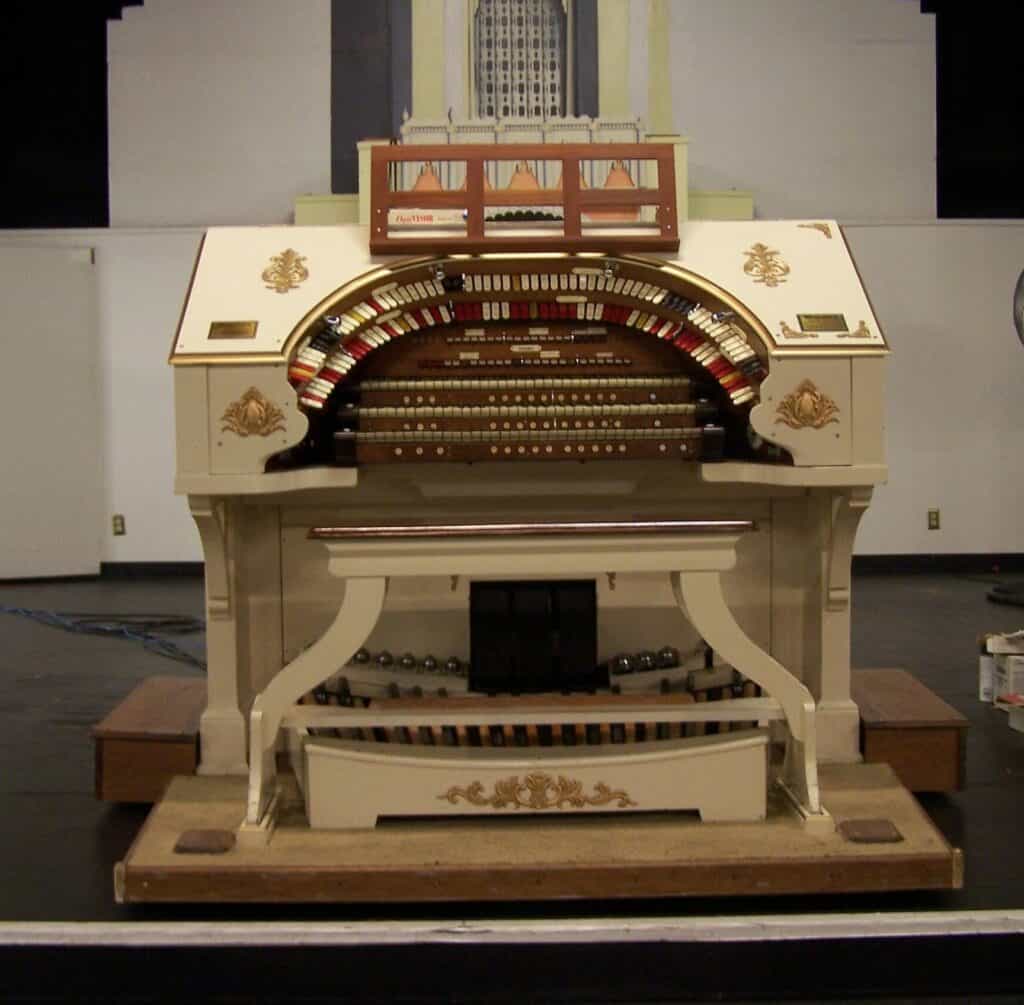From the Days of Silent Film
When Timothy Pflueger designed the Theatre in the late 1920’s he included a full size Wurlitzer Theatrical Pipe Organ to be installed into two chambers, one on each side of the grand proscenium arch.

The Oroville State Theatre is a “vaudeville” theatre, designed to provide live performing art productions as well as film events for the community of Oroville. At the time, film was silent and theatrical pipe organs gave them their sound and sensitivity. Obviously, the organs played the musical score, but did you know they also “spoke” the actors’ dialogue with tone and inflection so that the audience could “hear” what they saw on the screen in subtitle.
Then There was the Pie in the Face
But that’s not all. The organ made the horses gallop, the boats whistle, the dogs bark and yes, the splat when the pie hit the face! Many sound effects are contained in a combined device called a “toy counter.” But some of the effects are clever manipulations of the pipes to make the dog bark or the engine chug.

The organ was the voice of the silent film and became an integral part of the theatres where silent films were shown. Organists were musicians, of course, but they were also artists in their own right, providing their personal interpretation of the musical scores to delight the audiences! When you watch a silent film with a talented organist operating a theatrical pipe organ, you lose yourself in the film and forget that there is no soundtrack coupled with the images on the screen. You are transported into the story as effectively as “talkies” by the wonder of the pipes, the valves and the artist at the console.
The organ was also used for live performances and to provide ambiance and welcome as guests arrived as well as when they departed. The pipe organ was an integral companion to the grand palaces of their era.
Oroville’s Organ
The Oroville State Theatre has always been a symbol of prosperity and in stressful times such as WWII, a haven for the residents to find laughter, hope, distraction from worry and despair.
This symbol of hope and prosperity is what STAGE seeks to restore to the community! The organ is the first full restoration project to do just that! STAGE’s commitment to this restoration is the reason the Sierra Chapter of the American Theatre Organ Society determined to donate this very special organ to Oroville in 2011.
A special thanks goes out to the many individuals, families, and organizations that participated in our Adopt-a-Pipe fundraiser, helping us restore this marvel and create a legacy for many generations to enjoy! As you visit the Oroville State Theatre, you can view each adopted pipe’s registration details mounted on a legacy monument in the lobby for all time!
Wholly original Wurlitzer organs are rare, and as such this one has a storied history. Its core is the pipe organ from the private home theatre belonging to the famed American film producer Cecil B. De Mille. The console came from the Lowe’s Theatre in Saint Louis, Mo, and additional ranks of pipes were added to complete the organ that was installed in the Historic Oroville State Theatre. It consists of a three register console and seventeen ranks of pipes plus percussion instruments and a toy counter. The installation began in the fall of 2017, in celebration of the Theatre’s 90th anniversary celebration in April 2018!
In order to make room for all the pipes, STAGE opened the second chamber with an access door cut into the back stage theatre wall in January 2017. The original chamber was repaired from “repurposed” utilizations and prepared to receive components during the summer of 2017. The second chamber was prepared for components in early 2018. Final restoration work was completed in late 2020 during the COVID19 pandemic.





A great many contributions came together in a cascade of miracles on Myers Street to make this historic restoration possible, and STAGE is proud to leave this legacy to its community!
About the Wurlitzer Theatrical Pipe Organ
A theatrical pipe organ is a marvel of valves, tubes and air! Together, they make the sounds of an entire orchestra plus special sound effects!
In our theatre’s organ, all of this is created by 1137 pipes in seventeen ranks of metal and wood pipes that emulate the sounds of orchestra instruments. Some pipes are small and others are very large. The smallest pipes are bound together in ranks or octaves. There are twelve actual percussion instruments played by air pressure, such as a piano, marimba, glockenspiel and cymbal. And of course, the “toy counter” with 14 unique sound effects, including horse hooves, train whistle and an a-ooo-gah horn.
The beautiful console you may have seen in the lobby, or later in the main auditorium, is like the keyboard of the computer, while the pipes and instruments are the computer itself. The console gives artistry to the sounds. Together, the console, the pipes, and the instruments create the magic that is the Wurlitzer Theatrical Pipe Organ. Together they give the Theatre its unique personality–its voice!
You can help support the State Theatre by volunteering, donating, or becoming a member today!